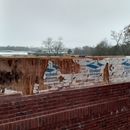Why you need an air gap between your cladding and your WRB

I recently talked to Karl Wages, a builder from Irvington, Alabama, who is repairing a brick-veneer building with a water entry problem.
The mason failed to maintain the required air gap between the brick veneer and the WRB. At this building, the WRB was a single layer of Dow Weathermate housewrap. After just a few years, the housewrap deteriorated — probably because the damp mortar is alkaline, and the mortar was touching the housewrap.
Karl sent me the photo below.
There are many lessons here:
1. If possible, keep on eye on your mason’s work.
2. Only hire masons whose work you trust.
3. One layer of WRB behind brick veneer is risky; two are better. In most cases, the best material behind brick veneer is a layer of rigid foam.
4. Always maintain an air gap between the brick veneer and the WRB.
.
GBA Detail Library
A collection of one thousand construction details organized by climate and house part










Replies
I wonder of the builder/homeowner was trying to save money on concrete by pouring a narrower than recommended brick ledge consequences be damned?
Karl told me that it was sloppy work by the mason. The brick veneer gradually went out of plumb as the mason added more courses of bricks, until everything was flush with the housewrap.
P.S. Karl also noted that there was a major flashing problem at the parapet cap.